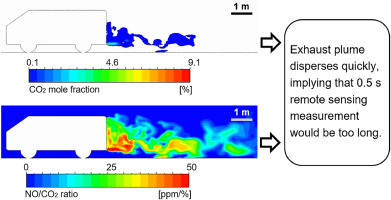Environmental Pollution ( IF 8.9 ) Pub Date : 2020-01-11 , DOI: 10.1016/j.envpol.2020.113974 Yuhan Huang 1 , Elvin C Y Ng 2 , Nic C Surawski 1 , Yat-Shing Yam 3 , Wai-Chuen Mok 4 , Chun-Ho Liu 5 , John L Zhou 1 , Bruce Organ 2 , Edward F C Chan 6

|
On-road remote sensing technology measures the concentration ratios of pollutants over CO2 in the exhaust plume in half a second when a vehicle passes by a measurement site, providing a rapid, non-intrusive and economic tool for vehicle emissions monitoring and control. A key assumption in such measurement is that the emission ratios are constant for a given plume. However, there is a lack of study on this assumption, whose validity could be affected by a number of factors, especially the engine operating conditions and turbulence. To guide the development of the next-generation remote sensing system, this study is conducted to investigate the effects of various factors on the emissions dispersion process in the vehicle near-wake region and their effects on remote sensing measurement. The emissions dispersion process is modelled using Large Eddy Simulation (LES). The studied factors include height of the remote sensing system, vehicle speed, acceleration and side wind. The results show that the measurable CO2 and NO exhaust plumes are relatively short at 30 km/h cruising speed, indicating that a large percentage of remote sensing readings within the measurement duration (0.5 s) are below the sensor detection limit which would distort the derived emission ratio. In addition, the valid measurement region of NO/CO2 emission ratio is even shorter than the measurable plume and is at the tailpipe height. The effect of vehicle speed (30–90 km/h) on the measurable plume length is insignificant. Under deceleration condition, the length of the valid NO/CO2 measurement region is shorter than under cruising and acceleration conditions. Side winds from the far-tailpipe direction have a significant effect on remote sensing measurements. The implications of these findings are discussed and possible solutions to improve the accuracy of remote sensing measurement are proposed.
中文翻译:

车辆尾气排放的大涡模拟:对道路遥感测量的影响。
公路遥感技术测量污染物与CO 2的浓度比当车辆经过测量地点时,气体会在半秒钟内进入尾气柱,为车辆排放的监测和控制提供了一种快速,无干扰且经济的工具。这种测量的一个关键假设是,对于给定的羽流,排放比是恒定的。但是,对此假设缺乏研究,其有效性可能受到许多因素的影响,尤其是发动机工况和湍流。为了指导下一代遥感系统的发展,本研究旨在研究各种因素对车辆近尾流区排放扩散过程的影响及其对遥感测量的影响。使用大涡模拟(LES)对排放扩散过程进行建模。研究的因素包括遥感系统的高度,车速,加速度和侧风。结果表明,可测量的CO2和NO废气羽流在30 km / h的巡航速度下相对较短,这表明在测量持续时间(0.5 s)内,大部分遥感读数低于传感器检测极限,这会扭曲导出的排放比。另外,NO / CO 2排放比的有效测量区域甚至比可测量的羽流更短,并且处于排气管高度。车速(30–90 km / h)对可测量羽流长度的影响微不足道。在减速条件下,有效NO / CO 2的长度测量区域比巡航和加速条件下要短。远尾管方向的侧风对遥感测量有重大影响。讨论了这些发现的含义,并提出了提高遥感测量精度的可能解决方案。


























 京公网安备 11010802027423号
京公网安备 11010802027423号